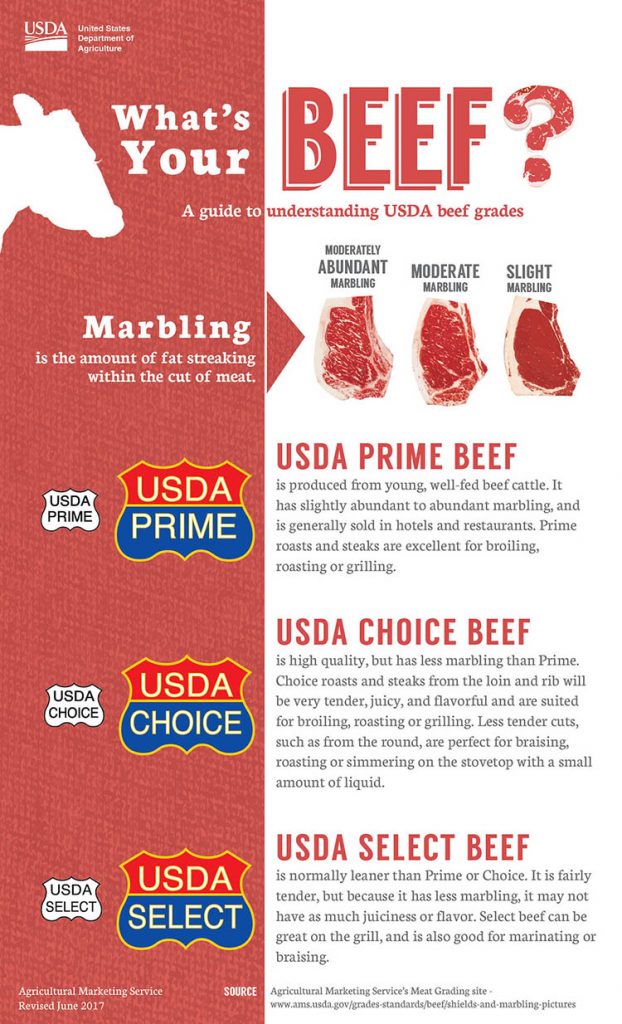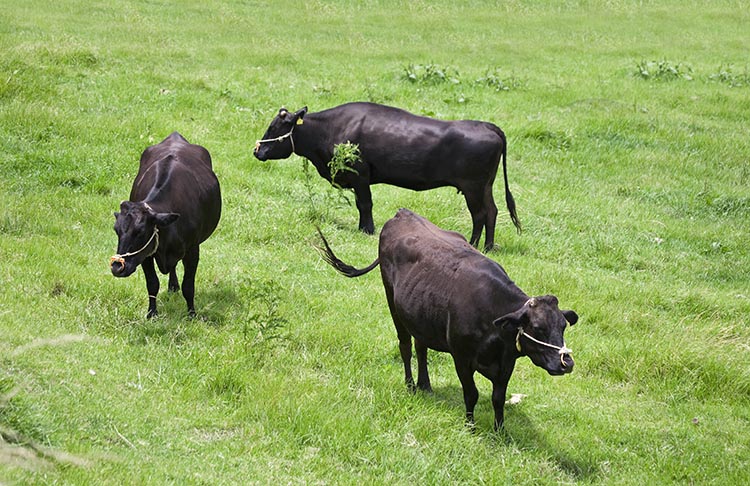Shopping for beef can be an overwhelming experience. Labels like grass-fed, organic, pasture-raised, and dry-aged just scratch the surface of available options.
While these are all important considerations, the USDA grades of beef are an easy way to quickly understand the quality of the meat you buy.
In this guide, we’ll explain how the USDA grading system works and how they grade beef worldwide.
How is beef graded?
In the United States, beef is graded in two ways:
- Quality grades for tenderness, juiciness, and flavor.
- Yield grades determine the carcass’s amount of usable lean meat.
Let’s start with beef quality grades. The USDA grades beef as Prime, Choice, or Select, primarily based on two factors:
1. Marbling
The meat’s degree of intramuscular white fat flecks is called marbling, and it generally makes beef more tender, juicy, and flavorful. Higher marbling also protects beef from overcooking and prevents it from drying out.
2. Maturity
The maturity of the carcass, or the estimated age at which the animal was slaughtered, directly affects tenderness. The older the cattle, the less tender the beef is.
There are five maturity groupings:
- A: 9 to 30 months
- B: 30 to 42 months
- C: 42 to 72 months
- D: 72 to 96 months
- E: more than 96 months
Experts determine a beef carcass’s maturity by evaluating its bones, cartilage, and the rib-eye muscle’s color and texture.
Fun facts: In young cattle, there’s a cartilage “button” on the top of each backbone. This slowly ossifies and changes to bone during maturation. Young cows also have narrow, oval-shaped, and red ribs. The ribs become greyer, flatter, and broader as they mature.
The USDA calls its grades a “language” in America’s beef industry to fast-track business transactions and make life easier for consumers.
The grading is done by highly trained specialists who use the quality and yield grades mentioned to determine the overall grade.
USDA beef grading is a voluntary process through which beef packers pay the Department of Agriculture to apply a subjective grade to their meat.
USDA grades of beef explained

Infographic courtesy of USDA
Prime
Prime is the highest grade of US beef, and less than 2% of all beef is graded Prime. It’s known for being extra tender, juicy, and flavorful.
Prime meat has significant marbling and is composed of around 8 to 13 percent fat. The beef comes from younger, grain-fed cattle, up to a maximum of B-Maturity or 42 months old.
Prime beef has long been associated exclusively with high-end restaurants, specialty butchers, and top steakhouses. However, as the amount of prime meat on the market has increased, it has trickled down into select supermarkets and online meat delivery suppliers.
How to cook Prime beef
Prime roasts and steaks (rib-eye, tenderloin, T-bone, and porterhouse included) are perfect for dry-heat cooking like broiling, roasting, or grilling.
Choice
Choice beef still represents high-quality meat but has moderate marbling and a lower fat percentage than Prime (from 4 to 10 percent). It comes from the same maturity range as Prime beef, sourced from the loin and ribs of young, well-fed cattle.
Angus beef, a well-regarded breed, is the most common example of Choice grade.
Over 50% of cattle receive this rating. Choice beef is now widely available in supermarkets at increasingly competitive prices. You’ll also regularly find it at restaurants and local barbecue joints.
How to cook Choice beef
Choice rib-eye and sirloin steaks are slightly less tender than Prime beef cuts. So they benefit from being braised, simmered, and roasted. The result is still deliciously juicy beef at a great price.
We frequently cook Choice beef with dry heat. Just know it’s more susceptible to overcooking, so keep a close eye on it.
Select
Select beef is commonly found in supermarkets and is the most affordable option. It’s much leaner than the higher grades, which means it doesn’t have the same level of tenderness.
It also exhibits slight marbling and contains just 2 to 4 percent fat, so you can expect it to look much more uniform. Select beef has the USDA seal of approval, though, so you know it’s still high quality.
It’s taken from young, well-fed A-Maturity cattle (or those under 30 months).
How to cook Select beef
Only the most tender Select cuts, such as loin, rib, and sirloin, are good for grilling as is—other Select-graded beef benefits from tenderizing and marinating. I recommend using it for smoking, braising, or stewing to bring moisture back into the beef.
Other grades of beef
There are 5 lower grades of beef than Select:
- Standard is typically sourced from more mature cows and has very little marbling. It’s often sold ungraded in grocery stores or as store-brand products. You’ll find it’s the most affordable option in grocery stores. Definitely tenderize and marinate Standard beef before cooking.
- Commercial is very similar to Standard, with low marbling and cut from mature cattle. Commercial is often mixed with other beef cuts to make lean ground beef.
- Utility, Cutter, and Canner are grouped because they’re rarely found in stores. Utility is sometimes used to make ground beef and processed products like frozen meals and canned stews. Cutter and canned are found in products such as pet food.
Beef Yield Grade
Beef producers use yield grade for marketing purposes. The USDA grades yield during harvesting to determine how much meat they collect from each carcass.
The USDA yield grades are a 1 to 5 score that’s judged on these factors:
- Fat thickness
- Rib-eye area
- Kidney, pelvic, and heart fat (KPH): The internal fat around the organs usually sits between 1.5 and 4 percent.
- Hot carcass weight: The weight of a hot carcass minus the hide, head, and internal organs. It’s typically around 60%.
The higher the score, the more fat on the 4 primal cuts: chuck, rib, round, and loin. 1 is primarily red meat (a.k.a. Select), and 5 is extra fatty (or Prime).
The problems with the USDA grading system
While the USDA system makes it easier to categorize beef quality quickly, it’s not without limitations.
One of the main issues is the narrow criteria the USDA uses for grading the beef. The system is based on the idea that marbling and maturity are the most crucial factors in meat quality. This approach is now much less widely accepted.
USDA beef grades don’t consider the level of nutrients in the meat, the process used to raise the animal, or the animal’s diet. It also doesn’t take animal breeds into account.
Online butcher Porter Road focuses on how the animal is raised rather than how it’s graded.
“We care more about how the animal is raised versus how it is graded”
Porter Road
You could argue this is a marketing tactic to sell lower-graded beef. However, when their farmers have been graded, it has returned as either Prime or Choice Plus.
The grading system also doesn’t value other essential factors to consumers. For example, grass-fed beef typically has lower levels of marbling than corn-fed meat. So it’s often graded lower, despite many people preferring the taste.
The grading system also only examines one cut, the rib-eye between the 12th and 13th ribs, to determine the grade of the whole carcass. This narrow grading excludes essential factors like taste, breed, cut, and fat quality.
The history of USDA beef grading
It’s helpful to understand a little bit about the history behind how beef gets graded.
Beef grading in the US was developed in 1927 as a form of marketing for the beef industry.
Farmers were suffering an agricultural recession in the 1920s, and they hoped the implied quality of the higher grades of beef would increase the demand for fatty corn-fed cattle.
For around 30 years, most beef graded under this new system came from Angus and Hereford cattle imported from Britain that produced fatty meat.
In the late 1960s, studies linked fat with heart disease. These studies, primarily funded by the sugar industry, led to Americans preferring leaner beef cuts.
In reaction, the USDA reduced its marbling requirement for Prime, Choice, and Select-graded beef.
These days, beef in the US generally comes from cattle that are 15 to 24 months old and have been “finished” with a grain diet during the last 8 months of their life to increase the fat level.
As you know, this high-fat finishing and the animal’s age are significant factors in USDA grading.
What about Wagyu beef grades?
A lot of people mistakenly believe Wagyu is a grade of beef. This is incorrect.
When you see Wagyu offered at restaurants or supermarkets, it’s most likely domestic or American Wagyu from heavily crossbred animals with only trace amounts of Wagyu DNA.

Wagyu cattle grazing
These animals are still counted as Wagyu, as the word literally means “Japanese cow.” But they’re not used or exported as high-end beef products and have nothing in common with actual Wagyu or Kobe beef.
Wagyu beef has a slightly different grading system based on the Japanese Meat Grading Association (JMGA) guidelines.
Unlike the USDA system, the JMGA grades Wagyu beef on a scale of 1 to 5:
- Poor (Quality score of 1)
- Below Average (Quality score of 2)
- Average (Quality score of 3 or 4)
- Good (Quality score of 5 to 7)
- Excellent (Quality score of 8 to 12)
This grading system also considers a few more factors than the USDA system. Waygu beef is graded based on color, texture, and the amount of marbling.
If you want to try the real deal, you can now find a few online retailers importing and selling Wagyu directly to consumers.
Grades of beef around the world
The US isn’t the only country using a beef grading system.
The Australian beef grading system
Meat and Livestock Australia (MLA) grades beef using the Meat Standards Australia (MSA) system. This comprehensive system measures the meat’s color, marbling, fat depth, carcass weight, maturity, and even the pH balance.
The MSA scale runs from 100 (no intramuscular fat) to 1190 (extreme amounts of intramuscular fat) and goes up in increments of 10.
Occasionally, you might run into the older AUS-MEAT grading system, which runs from 0 to 9. AUS-MEAT advances in increments of 1, with 0 representing no intramuscular fat and 9 representing extreme amounts of intramuscular fat.
The Japanese beef grading system
We’ve already mentioned how the Japanese system grades Wagyu beef. The quality of the meat is graded 1 to 5, with 5 being the highest, based on the following factors:
- Meat marbling
- Meat color and brightness
- Meat firmness and texture, and
- Fat color, luster, and quality.
The same JMGA Beef Carcass Grading Standard applies to all beef in Japan with the addition of a yield grade.
The Japanese yield grade is graded from A to C:
- A typically indicates a full-blooded Wagyu cow.
- B is usually a crossbred Wagyu animal.
- C generally is Angus or Holstein cattle.
Sometimes, it’s okay to ignore the grading
The USDA grades of beef are clearly a helpful guideline on the beef’s marbling and maturity.
But remember, the USDA system doesn’t cover what cut you’re buying, what the animal was fed, and how it was raised. 100% grass-fed, older, and more flavorsome beef doesn’t fit neatly into the system.
When considering these factors, ignoring the USDA rating entirely is perfectly okay.
Do you have any cooking tips for different USDA grades? We’d love it if you’d let us know in the comments below!
Did you miss our previous article...
https://manstuffnews.com/backyard-grilling/31-easy-game-day-recipes
 Backyard GrillingWeekend WarriorsAdvice from DadBeard GroomingTV Shows for Guys4x4 Off-Road CarsMens FashionSports NewsAncient Archeology World NewsPrivacy PolicyTerms And Conditions
Backyard GrillingWeekend WarriorsAdvice from DadBeard GroomingTV Shows for Guys4x4 Off-Road CarsMens FashionSports NewsAncient Archeology World NewsPrivacy PolicyTerms And Conditions
